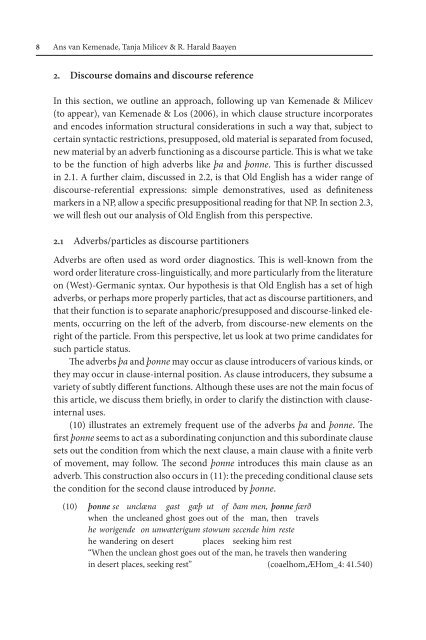Selected Papers from the Fourteenth International ... - STIBA Malang
Selected Papers from the Fourteenth International ... - STIBA Malang
Selected Papers from the Fourteenth International ... - STIBA Malang
You also want an ePaper? Increase the reach of your titles
YUMPU automatically turns print PDFs into web optimized ePapers that Google loves.
Ans van Kemenade, Tanja Milicev & R. Harald Baayen<br />
2. Discourse domains and discourse reference<br />
In this section, we outline an approach, following up van Kemenade & Milicev<br />
(to appear), van Kemenade & Los (2006), in which clause structure incorporates<br />
and encodes information structural considerations in such a way that, subject to<br />
certain syntactic restrictions, presupposed, old material is separated <strong>from</strong> focused,<br />
new material by an adverb functioning as a discourse particle. This is what we take<br />
to be <strong>the</strong> function of high adverbs like þa and þonne. This is fur<strong>the</strong>r discussed<br />
in 2.1. A fur<strong>the</strong>r claim, discussed in 2.2, is that Old English has a wider range of<br />
discourse-referential expressions: simple demonstratives, used as definiteness<br />
markers in a NP, allow a specific presuppositional reading for that NP. In section 2.3,<br />
we will flesh out our analysis of Old English <strong>from</strong> this perspective.<br />
2.1 Adverbs/particles as discourse partitioners<br />
Adverbs are often used as word order diagnostics. This is well-known <strong>from</strong> <strong>the</strong><br />
word order literature cross-linguistically, and more particularly <strong>from</strong> <strong>the</strong> literature<br />
on (West)-Germanic syntax. Our hypo<strong>the</strong>sis is that Old English has a set of high<br />
adverbs, or perhaps more properly particles, that act as discourse partitioners, and<br />
that <strong>the</strong>ir function is to separate anaphoric/presupposed and discourse-linked elements,<br />
occurring on <strong>the</strong> left of <strong>the</strong> adverb, <strong>from</strong> discourse-new elements on <strong>the</strong><br />
right of <strong>the</strong> particle. From this perspective, let us look at two prime candidates for<br />
such particle status.<br />
The adverbs þa and þonne may occur as clause introducers of various kinds, or<br />
<strong>the</strong>y may occur in clause-internal position. As clause introducers, <strong>the</strong>y subsume a<br />
variety of subtly different functions. Although <strong>the</strong>se uses are not <strong>the</strong> main focus of<br />
this article, we discuss <strong>the</strong>m briefly, in order to clarify <strong>the</strong> distinction with clauseinternal<br />
uses.<br />
(10) illustrates an extremely frequent use of <strong>the</strong> adverbs þa and þonne. The<br />
first þonne seems to act as a subordinating conjunction and this subordinate clause<br />
sets out <strong>the</strong> condition <strong>from</strong> which <strong>the</strong> next clause, a main clause with a finite verb<br />
of movement, may follow. The second þonne introduces this main clause as an<br />
adverb. This construction also occurs in (11): <strong>the</strong> preceding conditional clause sets<br />
<strong>the</strong> condition for <strong>the</strong> second clause introduced by þonne.<br />
(10) þonne se unclæna gast gæþ ut of ðam men, þonne færð<br />
when <strong>the</strong> uncleaned ghost goes out of <strong>the</strong> man, <strong>the</strong>n travels<br />
he worigende on unwæterigum stowum secende him reste<br />
he wandering on desert places seeking him rest<br />
“When <strong>the</strong> unclean ghost goes out of <strong>the</strong> man, he travels <strong>the</strong>n wandering<br />
in desert places, seeking rest” (coaelhom,ÆHom_4: 41.540)










